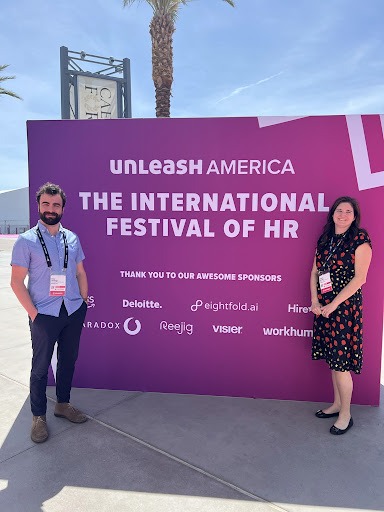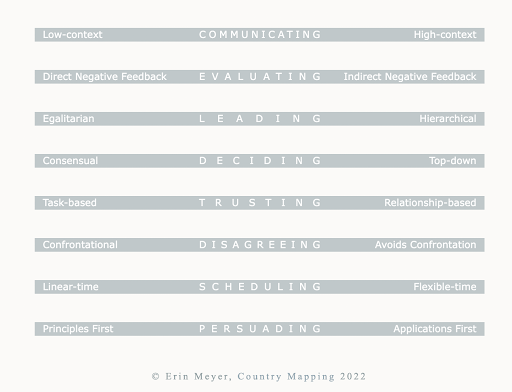UNLEASH America 2023 Conference Recap
In this UNLEASH America 2023 conference recap, we reflect on some of the most interesting sessions we had the opportunity to attend around pay transparency, company culture, employee engagement and the future of work.
Stories Inc.’s own Peter Jennings and Lauryn Sargent attended the UNLEASH America conference in Las Vegas. Everywhere you looked, there were engaging sessions about AI, company culture, and the future of work. We couldn’t attend them all, even though we wanted to!

In this post, we’ll share our biggest lessons learned from sessions at the conference. Let’s jump into it!
Panel: Pay Transparency
Hosted by John Vlastelica, Recruiting Toolbox
Panelists:
- Jane Curran, Global Head of Talent Acquisition, JLL
- Susan Chu, Head of Total Rewards, Third Bridge
- Simon Grace, VP of Global People Services, Trimble
Included in the pre-event summits was a fascinating panel on pay transparency. Panelists talked through what they’ve learned implementing pay transparency within their companies as well as the wider cultural trend it presents.
Some background on pay transparency: depending on the jurisdiction, employers can’t legally ask candidates for their salary history and may be required to disclose pay ranges for current and open positions. Eight states have passed legislation related to pay transparency. But, even employers who don’t have to comply are considering it given the impact it has on the candidate and employee experience as well as company culture in general.
Pay transparency is a giant leap forward to build trust with employees as well as candidates. But it’s not as simple as it seems.
Publishing pay ranges on job descriptions isn’t the most difficult part of complying by law or committing to a culture of pay transparency. The hard part? The aftermath of what pay transparency does internally. In fact, one panelist went forward with pay transparency externally, only to retract their efforts when it was clear there was work to complete internally first.
Most of these internal challenges are because of the disruptive nature of salary disclosures across an organization. John Vlastelica described pay transparency as a “forcing function” – you wouldn’t be having conversations with employees about compensation otherwise. It forces managers to have conversations about why certain employees are on the lower part of the salary band, often having to confront performance issues. There is also an additional friction when employees know how much their managers are paid in relation to their own compensation.
But for all that discomfort, the panel agrees that pay transparency is absolutely the right decision for their respective organizations. The need for pay transparency reflects the general trend towards increased corporate accountability and an emphasis on company culture. Here’s why:
- Simon Grace remarked that pay transparency is not just the right thing do, it’s also good business because it inspires productive performance conversations. There’s forced accountability for managers make better decisions because they have to explain to employees and candidates why they are considered at the bottom or below the pay band.
- Susan Chu noted that the current generation of employees at work are already talking about how much they make — so it only makes sense for organizations to publish the information, too, since the information is already out there.
- Jane Curran thinks pay transparency is an important part of being an employer of choice, especially for a company like JLL that wants to attract progressive candidates. Pay transparency is a key culture principle with this talent segment.
- Candidates understand it’s not just the salary alone that makes or breaks an opportunity; they want to talk about total cash compensation, culture, career growth, work/life balance. When publishing compensation ranges, know that most candidates realize there is more to the story/offer.
- It gets recruiters out of a “deal mentality,” which can perpetuate inequality. It also can make the recruiting process faster.
One of our favorite quotes came from Jane Curran at the end:
“Use the information for good, because if you look for a deal then you perpetuate the problem – don’t pay anyone less than the 25% percentile, not even kind of!”
With pay transparency comes a cascading positive impact, including more ethical and equitable hiring practices, honest conversations about performance management, and building trust with employees and candidates.
Thriving Through the Human Energy Crisis, Microsoft
Kerry Olin, Corporate VP HR Services at Microsoft talked about the “human energy crisis” (burnout at work). 48% of employees and 53% of managers report they’re burned out at work. The symptoms of burnout are exhaustion, cynicism, detachment, and lack of accomplishment. And, 7 out of 10 employees surveyed said they were struggling with their mental health.
Microsoft’s research found that during a year of economic instability, the most engaged organizations performed twice as well financially than those with low engagement amongst employees.
So as a company leader, how can you best re-engage and re-energize your team?
Here are 6 recommended solutions from the presenter (plus Stories Inc. links to show you how to communicate these culture concepts):
- Put culture and purpose front and center
- Focus on leader and manager capabilities
- Support career growth
- Make wellbeing holistic
- Be intentional to offer flexibility where possible
- Build supportive team connections
Panel: Putting People First
Moderated by Kate Graham, Director of Content Labs and Insight at UNLEASH
Panelists:
- Alan Susi, Global Head of Organizational Analytics & People Insights at S&P Global
- Summer Baruth, Head of Global Employer Brand & Talent Attraction at AECOM
- Maureen Jules-Perez, Head of Diversity, Inclusion and Belonging at Capital One
This trio of speakers had a compelling conversation about the importance of putting people first in the hierarchy of organizational decisions. Companies with high-trust cultures historically have stronger stock market returns than those that don’t. But, what is the key to establishing that culture of trust?
For Jules-Perez, the key is listening. “We consistently do surveys, host skip levels or round tables, and I will sit in and just listen – I won’t even respond. It allows the group to build trust among each other and I’ll pull out the themes.” This allows their team to invest in the right areas to keep their people feeling heard and happy.
At the heart of that process, is the priority of retaining talent. According to Jules-Perez, typically 25-30% of employees are at least entertaining external job opportunities. Losing great people is expensive not only in the obvious ways around hiring costs, but also in slowing productivity, innovation and team morale. At Capital One, they invest in talent mobility by posting roles to their internal network at least once a month, or showing ways in which their people can grow their skills. This is vitally important for those that may have been passed up for promotions.
“If you’re not investing in, and showing people how they can get to the next level, they will go somewhere else to do that,” Jules-Perez said.
Baruth, Head of Employer Brand and Talent Attraction at AECOM, believes another key part to developing a culture of trust is by recognizing your employees. They launched “AECOM Voices,” a LinkedIn channel with nearly 10,000 followers already, where employees can post their own stories and have their voices heard. But, the AECOM team wanted to take this channel further. So, they started asking managers if they could better celebrate work anniversaries by creating content that spotlights their people, and the results have brought Baruth tears of joy!
She shares, “The amount of emails that my team receives after we’ve highlighted employees externally is what makes me tear up.” She consistently hears that people want to share what they love about their job, or the team they work with. “It’s kind of cool to live in the Middle East, and have people all over the world share congratulations, because now they really feel that connectivity.”
Bonus: Culture Map
Author Erin Meyer walked through her research on how different business cultures around the world measure on 8 different scales.

Fun fact: Americans give more positive feedback than any other culture. Plus, check out this cool country mapping tool!
This was particularly interesting to us as Stories Inc. travels the world interviewing employees in different offices. We’ve seen first hand the differences in how employees share their work experiences.
Thanks for a great few days of learning, UNLEASH!
We hope you enjoyed this recap of the UNLEASH America 2023 conference. We left the conference inspired, engaged, and excited to continue building the future of work. Thanks to all the amazing speakers for sharing their insights. Until next time, UNLEASH!

